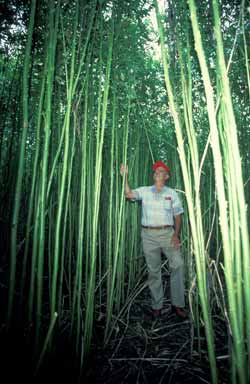Malaysian researchers create new durable wood-plastic composite material

Kenaf (Hibiscus cannabinus), is a plant in the Malvaceae family. Kenaf is cultivated for its fibre in India, Bangladesh, United States of America, Indonesia, Malaysia, South Africa, Viet Nam, Thailand, parts of Africa, and to a small extent in southeast Europe.<br>
Wood-plastic composites (WPCs) are one of the fastest growing construction components in the wood composites industry. Their popularity is due to low maintenance, high durability, and resistance to termites and other insect attacks. However their widespread usage has been limited due to their high cost in production and in some instances low strength.
The present study focused on assessing the suitability of kenaf core fraction (about 65%of the whole stem of the plant) in powder form as filler material. Kenaf powder, processed from its core fibre, has been shown to offer one potential solution to the increasing scarcity of traditional filler materials. Kenaf stems contain two distinct fibre types, bast and core. Dosing with maleic-anhydride-modified polypropylene (MAPP) in the right amount displayed not only to bridge the interface between the ground kenaf core (GKC) and plastic in the present WPCs, improving stress transfer and increasing their strength and stiffness, but also allow a higher filler loading. Reducing the amount of plastic and increasing the amount of GKC, without sacrificing strength, stiffness or durability, would result in greener WPC products.
Researchers examined the possibility of replacing sawdust with GKC and measured the mechanical properties of the resulting composites. They also looked at the effect of increasing maleic-anhydride-modified polypropylene (MAPP) dosage. Material preparation included GKC drying followed by high intensity blending with polypropylene (PP), coupling agents (MAPP) pellets, and feeding this into a counter-rotating twin-screw extruder for compounding. Compounded blends were then fed to an injection-moulding machine to produce boards of dimensions 153mm x 153mm x 3mm. Specimens were cut from the boards for tensile and bending tests in five replicates. GKC formulation gave the highest average tensile strength, modulus of rupture and modulus of elasticity.
WPCs of polypropylene (PP) and ground kenaf core (GKC) fibre, dosed with maleic-anhydride-modified polypropylene (MAPP) in the right amount, was found not only to bridge the interface between the GKC and plastic, improving stress transfer and increasing their strength and stiffness, but also allow a higher filler loading of 65%. Reducing the amount of plastic and increasing the amount of GKC, without sacrificing strength, stiffness or durability, would result in greener WPC products. The researchers recommend that additional testing and extended research is necessary to investigate the strength of WPC on mechanical properties of modulus of elasticity (MOE) and modulus of rupture (MOR) by carrying out impact test and compressive test which could reveal new discoveries about high filler loading WPCs.
ARUAN EFENDY MOHD GHAZALI
aruan624@salam.uitm.edu.my
Ir. SHAHARIN HAMID
Ir. ABDUL HALIM ABDUL GHANI
Funding information
Excellence Fund, Research Management Institute (RMI) University Teknologi MARA, Malaysia.
Media Contact
All latest news from the category: Materials Sciences
Materials management deals with the research, development, manufacturing and processing of raw and industrial materials. Key aspects here are biological and medical issues, which play an increasingly important role in this field.
innovations-report offers in-depth articles related to the development and application of materials and the structure and properties of new materials.
Newest articles

After 25 years, researchers uncover genetic cause of rare neurological disease
Some families call it a trial of faith. Others just call it a curse. The progressive neurological disease known as spinocerebellar ataxia 4 (SCA4) is a rare condition, but its…

Lower dose of mpox vaccine is safe
… and generates six-week antibody response equivalent to standard regimen. Study highlights need for defined markers of mpox immunity to inform public health use. A dose-sparing intradermal mpox vaccination regimen…

Efficient, sustainable and cost-effective hybrid energy storage system for modern power grids
EU project HyFlow: Over three years of research, the consortium of the EU project HyFlow has successfully developed a highly efficient, sustainable, and cost-effective hybrid energy storage system (HESS) that…





















